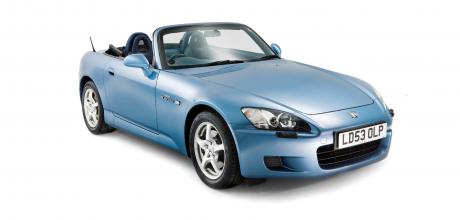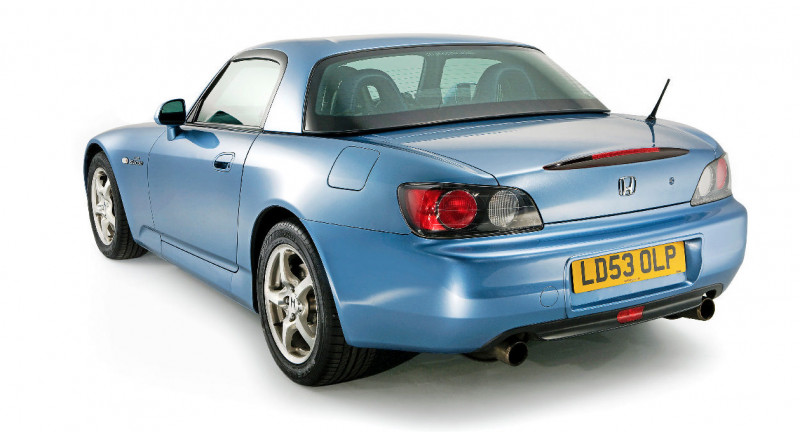Buying Guide Honda S2000

With numbers thinning and prices rising, now’s the time to move
Words RICHARD DREDGE, JAMES WALSHE AND SAM DAWSON
Photography MAGIC CAR PICS
Buying Guide It’s time to buy the Nineties’ most sought-after roadster – Honda’s S2000
Honda took nearly a decade to respond to arch-rival Mazda’s MX-5, but with the S2000 it established a new performance benchmark for small sports cars. Uncompromisingly tail-happy, wringing 237bhp from a lightweight high-revving four-cylinder, it made similarly priced BMW and Audi offerings look underwhelming and tame by comparison. Nowadays, its values are head and shoulders above its supposedly more prestigious rivals. As rust and track-day accidents claim them, they’re getting rarer and correspondingly more expensive. But this makes them a safe place for your money, as well as a highly entertaining one.

To guide you to a good Honda S2000, we’ve tapped into the expertise of Tom Gannon of TGM Sport, Barrie Rycroft of DCY Europe, and Honda specialist Justin Haydon of JDT Tuning.
Which one to choose?
- Evolved from the 1995 Honda SSM (Sports Study Model) concept, the Honda S2000 roadster was launched in 1998. A flurry of changes began with a minor facelift in 2004, with redesigned headlights and 17-inch wheels. Traction control fitted as standard from 2006. The GT model, released in 2004, featured an aluminium hardtop and temperature gauge as standard. A GT100 special edition marked the end of production in 2009 – essentially a GT with special white paint.
Bodywork
There are differing stories regarding the S2000’s ability to stave off rust. Some cars have barely been affected, while others exhibit severe corrosion around the sills, subframes and wheelarches. This rust is often impossible to find with just a cursory check – especially the inner wheelarches, which hide behind plastic covers. Bear in mind that rust could well be a sign of poorly repaired track-day damage, which has implications for other areas of the car too. Rectifying the rust professionally could easily run to £600 per wheelarch, while a thoroughly rotten car could easily swallow £5000 to put right.
Check the roof carefully. Hardtops are aluminium so, while they don’t tend to suffer corrosion, they’re difficult to repair if damaged. Replacements complete with fitting kit can be as pricey as £3000 if they come with a stand, bearing in mind that the fitting kit alone can fetch up to £1000 if it’s unused. Be wary of any example featuring a temperature gauge but no hardtop – a sign of a GT that’s missing its roof.
If the car you’re looking at has a hardtop, ask the vendor to remove it so you can check the condition of the canvas hood beneath. Pre-March 2002 cars had plastic rear screens, later cars had glass. While replacing the plastic screen costs £400, the cost of replacing (or upgrading to) a glass item runs to £1000.
Engine
Don’t be lulled into a false sense of security by Honda’s reputation for reliability. The 2.0-litre VTEC unit in the S2000 needs fastidious care and attention, so check the service history. The engine needs a full change of fully synthetic oil every 9000 miles, and has a reputation for burning it in between scheduled services, so look for evidence of top-ups in the form of the correct oil bottle in the boot.

Look for hesitation in acceleration when pulling away from rest, which is a sign that the MAP (manifold absolute pressure) or lambda sensors have failed. These are relatively easy and cheap fixes, though. A MAP can potentially be cleaned and a replacement is £60. However, there are two lambda sensors that weigh in at £190 each. If replacing these doesn’t solve the problem, you may need new injectors (£1300 for a set), or coil packs (four at £125 apiece including fitting).
Overheating is rare but bear in mind the model year when checking the temperature gauge. It’s digital, and pre-2003 cars can show three bars on their graph before they’re considered to be into the danger zone. On post-2003 cars, it’s seven. With the timing gear chain-operated, there’s no snap-prone belt to worry about. However, little-used cars can suffer from faulty timing chain tensioners. Listen out for a rattle on start-up and at low rpm – and prepare for a £300 bill.
Suspension
As a track-day favourite, S2000s have often received punishment by rumble-strips and gravel traps as well as hard cornering. Worn bushes and neglected suspension that hasn’t been greased during services can soon result in a car out of alignment, not tracking straight or cornering as sharply as it’s meant to. Bushes can seize and are difficult to get to, requiring the parts to be cut to remove them, necessitating aftermarket replacements and a full professional alignment. Apparently minor suspension refresh work on an S2000 can easily eat £1500.
Brakes
The S2000’s handbrake is notoriously poor, and a common MoT test failure point, so make sure it can hold the car on an incline; addressing the problem is often just a case of lubricating the mechanism during servicing. See if the seller parks the car in gear rather than on the handbrake – cars that have been left parked for extended periods with the handbrake on can suffer from binding calipers.
Interior and electrics
S2000s came with standard leather trim, which is very hardwearing and rarely suffers anything other than worn or split bolsters. Other issues relate mainly to electrics. The standard-equipment stereo wasn’t particularly powerful and was routinely replaced with an aftermarket item, the fitting of which often damages the plastic head unit surround on the dashboard – replacements are unavailable.
With Honda diagnostic tools available for as little as £40, it’s easy for unscrupulous owners to switch off warning lights before potential buyers come to view the car. However, with your own reader, it’s possible to see evidence of this having happened. Thankfully, electrical faults are rare.
‘The S2000 is a safe place for your money, as well as a highly entertaining one’
2002 Honda S2000, £16,750
Silverstone metallic over red leather, with new mohair soft top plus original tonneau cover. Four new brake calipers and master brake cylinder. Full Honda main dealer service history, the last just 850 miles ago. New Honda-fitted clutch. Bridgestone Potenzas all round, fitted 539 miles ago. Private plate valued at £775 included in the sale. Described as ‘overall excellent condition’ with 54,830 miles.
VTEC engine is reliable and tough, only if properly maintained Plug in a diagnostic reader to check for hidden electrical faults
‘They made similarly priced BMW and Audi offerings look tame’
Owning a Honda S2000
Lewis Plumb
Lewis is into his third year of Honda S2000 ownership. ‘I wanted a rear-drive sports car and these Hondas always appealed to me,’ he says. ‘They look great, and are comfy and usable. But it’s the sound of it that gets me the most. Driving a normal car feels weird and flat after driving an S2000.
‘Many were hammered round racetracks, so be wary. I wouldn’t rule out modified cars, though – you may find one that’s been done well. Reliable supercharger kits from specialists like TGM Sport can take them to 350bhp, though a poorly installed supercharger can cause overheating.
‘The UK S2000 Owners’ Club forums are very active, and parts and specialists are plentiful. Dealers don’t tend to have many for sale, though – it took a long time for me to find mine, but it has been totally reliable and relatively cheap to run.’
Anna Cleobury
Anna bought her S2000 in 2012. ‘I was looking for a Porsche Boxster, then saw the S2000 for sale at a garage and thought it looked better,’ she says. ‘It’s also rarer than the Porsche, just as fast, and superb to drive. It’s been as reliable as you’d expect from a Honda too. ‘The only real downside is the heavy fuel consumption – I average around 25mpg in mine. I’d avoid modified cars, because reliability may have been compromised. The standard car is so good it’s hard to see why you’d want to upgrade it. Be wary of anything with no service history – you’re better off taking your time to find one that’s been cherished by a club member rather than a tatty car that needs lots of money bringing it up to standard.’
What to pay
S2000s sell on condition rather than specification, especially as the GT’s standard hardtop was optional on other models – and in the UK we missed out on the hardcore, trackfocused Type S and Club Racer models. A scruffy project car in need of an overhaul might still be found for around £4500 but the herd is thinning. Usable cars in good order can be had from around £7000, adding a few thousand more for a GT. Low-milers with a full history start these days at about £11k – but double that for the very best.

